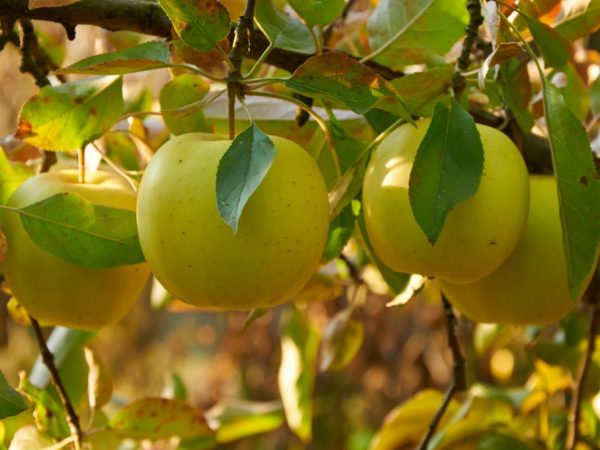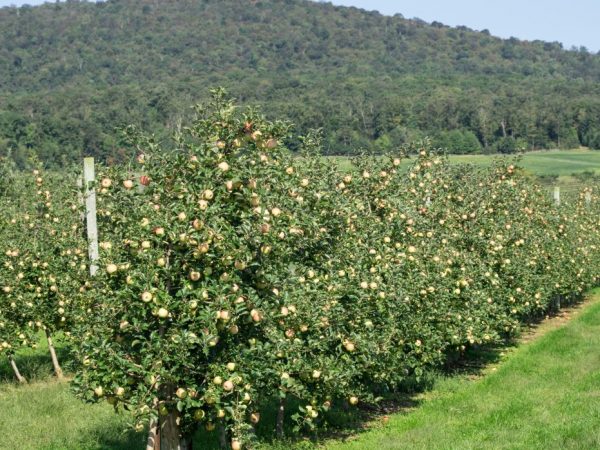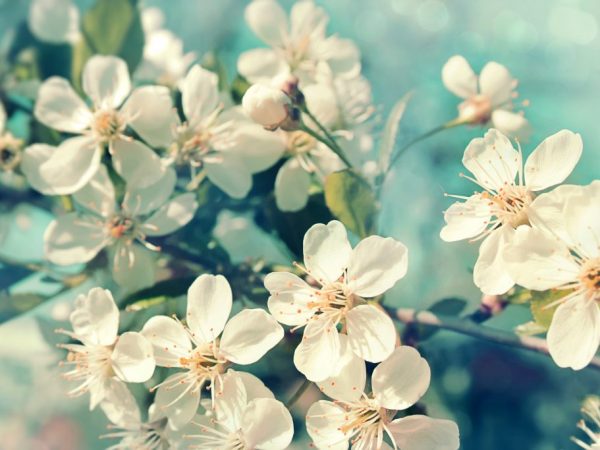Characteristics of the apple tree Papiroyantarnoe
Gardeners are always in search of unpretentious and at the same time well-bearing varieties. Among the fruit trees, these included the Papiroyantarnoye apple tree, which was artificially bred by the breeder L.A. Kotov. Its striking feature is its adaptability to changeable weather conditions.

Characteristics of the apple tree Papiroyantarnoe
Description
To appreciate this tree, you need to understand its distinctive features, thanks to which many want to grow an apple tree of this variety on their site.
Tree and fruit
The tree is classified as a medium-sized tree. It has a dense, rather dense, rounded crown and a strong stem system. There is an annual increase of 10 cm due to the addition of the upper kidneys.
The branches are almost at right angles to the trunk. This makes it possible to artificially form a stlate crown in regions with low temperatures in winter. Such a crown is created by bending the branches of a still young tree, and then the vertical shoots are removed.
The trunk is brown-gray and the branches are brown-gray. The glossy surface of the leaf is colored dark green, its shape is pointed, the tip is slightly curved.
The fruits grow in pairs on the tree and have a long stem. The size of apples is average, they weigh 100-150 g each, round in shape with pronounced ribbing. Fruits ready for harvest are green-yellow in color, when fully ripe on the tree they are yellow-amber.
The rind is dry and dense, does not have any blotches, blush. The flesh of apples is creamy white, dense, but rather juicy, the structure is fine-grained. The spicy aroma and sour-sweet taste make this variety a dessert one; housewives often choose it for their dishes.
Advantages and disadvantages
This tree has more advantages, since it is a selection variety, but there are some disadvantages to which you have to adapt.
The benefits of the apple tree include:
- resistance to unfavorable climatic conditions, including low temperatures;
- adaptability to the characteristics of the soil in different regions;
- she is not afraid of fungal diseases (with the exception of scab in abundantly wet years);
- high productivity.
Among the disadvantages of the variety are:
- short storage time for fruits (about 3 months), which is why most of them are processed;
- the tree needs additional cover to prevent freezing of the trunk and roots.
Taste
The palatability is more reminiscent of Papirovka, but surpasses it. The fruit of the Papiroyantarnoye apple tree has a more pronounced pleasant sweet taste with a slight sourness.
Yield

The variety will delight you with its yield
The first crop can be harvested already in the fifth year of planting. In the seventh year, the tree will fully bear fruit, and with an increase, the yield will only increase.On average, 60 centners of apples can be harvested per hectare; in rare years, this figure drops. Harvest at the end of summer, in the last week of August.
Pollinators
The tree is self-fertile, good weather with a breeze and insects are enough for its pollination. No other trees in the garden or special tools are required.
Winter hardiness
Trees can withstand temperatures down to -30 ° C. It is recommended to cover trees for the winter. Because the root system of a tree is located (in the bulk) on the surface, then it, like the trunk, can be subject to freezing and icing. This will not kill the tree, but it will noticeably affect the yield in the next fruiting season.
Disease and pest resistance
The apple tree is distinguished by its immunity to fungal diseases. Otherwise, it is not much different from other species. In weather conditions with heavy rainfall, the condition of the tree should be monitored, scab can damage it. It requires pest control.
Landing
Familiarize yourself with the planting features in advance so as not to buy a cutting at the wrong time.
Timing
Spring is considered the best time to plant. Do not rush, it is better to wait for the period when the earth is already well warmed up and the frosts are behind.
Planting in the fall is not advised, since the root system of the seedling is superficial, because of this it is vulnerable and may not survive the severe winter frosts.
Technology
Planting work is carried out as follows:
- for disembarkation, a recess with a diameter of 1 m and a depth of about 60 cm is prepared;
- the pit is filled with a mixture of the following components: peat, compost, rotted manure (powder) and humus. They dig everything up with the ground. Many are trying to get black soil, which is also a good option for planting;
- a seedling is placed in this hole and the roots are spread, and then they are buried in earth;
- we form a hole at the central conductor, it will be useful for collecting and preserving water resources for a tree;
- two buckets of water are enough for watering.
Important: when planting this tree on the site, keep the distance between trees at 4 m.
Care

The tree needs good care
Proper care after planting will allow you to get a strong, healthy, fruitful tree in the future.
The first and must-have item on this list will be watering. Watering the seedlings in the first year is necessary 4 times during the month, i.e. Once a week. In the following years, when the tree is already well rooted, watering will only be needed during periods of drought and vegetation.
Further - treatment from pests. For this purpose, the trunk is whitewashed with lime and copper sulfate in the spring, and additional organic and chemical substances are used.
As already mentioned, the first fruits can be tasted already in the fifth year of the apple tree's life. At first there are few of them, but every year the yield will grow. You need to take care of the supports for the branches so that they do not break under the weight of the fruit.
Wintering is an important period for this apple variety. It is necessary to cover the soil around the tree with compost, because the roots are located close to the surface, and this will help prevent them from freezing. For the trunk and crown, it is also necessary to select covering materials.
An important point is fertilizers. They can be of organic or mineral origin. The main thing is to start bringing them in from the third year of the apple tree's life, they will help the tree grow stronger and prepare for the first flowering.
Don't neglect cropping. For a good harvest, a tree does not need many shoots and branches. In the third year after planting, begin to form a crown, remove weak shoots in a timely manner. The places where there are many of them must be thinned out.
Harvesting and storage
You can see the beautiful flowering of the apple tree in mid-May. Because a variety of medium early maturity, by the end of the cold Siberian summer it just ripens. Harvesting can begin around the end of August.
Neatly picked apples are placed in wooden boxes and sent to storage in a dark, ventilated room. After a period of 2-3 months, they, unfortunately, begin to deteriorate.
Some gardeners advise to pluck the fruits for a longer storage slightly greenish, so they will last longer, eventually mature in a box.
Views
This variety has two varieties: on a dwarf rootstock and a summer one. They are similar, but the Papiroyantarnoe apple variety on a dwarf rootstock is rated higher.
On a dwarf rootstock
There are a number of advantages here:
- such a tree is convenient to care for and when harvesting, since its height does not exceed 2 m;
- good decorative properties;
- crop stability.
Summer
This type also has its advantages:
- allows you to save space due to the stock stock;
- resistant to scab, unlike apple on a dwarf rootstock;
- higher productivity.
Growing in regions
Initially, this fruit tree was bred for cultivation in the regions of the Urals and Siberia, where cold winters and short summers do not allow other varieties to ripen on time and grow well.
If you plan to grow a tree in the Siberian region, from the first year of planting, devote time to the plant: mulch the near-trunk circle with loose fertilizers, form the crown in a tiered order. A mandatory whitewashing is needed, and snow can be used as a heater, with which the crown is completely covered.
The peculiarities of growing a tree in the Urals are slightly different. Watering should be monitored more closely. Whitewashing is performed 2 times a year (in spring and autumn), traps and traps for rodents are useful.
Important: as soon as the period of snow melting begins, free the tree from the heap of snow, otherwise the branches may not withstand and break.
Gardeners reviews
All hardworking gardeners and summer residents are satisfied with the properties of this variety and in their reviews advise it for growing. They note the relative ease of maintenance. If you buy a good cutting, you will get a healthy fruiting tree in the future.

